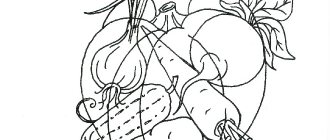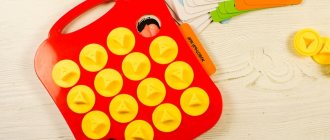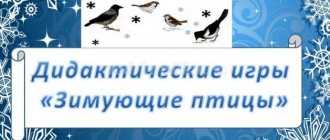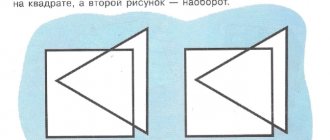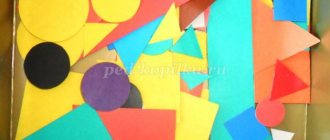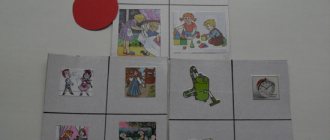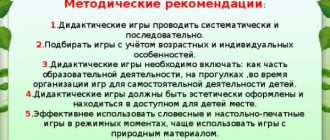Didactic games to develop ideas about geometric figures and the shape of objects
Didactic games for the development of ideas
about geometric figures and the shape of objects
II
junior group
Choose your figure
Purpose of the game
: To consolidate children’s ideas about geometric shapes, to practice naming them. Learn to name shapes based on the model. Strengthen the skill of examining geometric shapes using the technique of tracing and overlaying.
Material
: Demonstration: circle, square, triangle, cut out of cardboard. Handout: cards with outlines of figures, one figure each of the same size as the outline images.
Progress of the game:
The teacher shows a circle and, tracing it with his finger, asks: “What is the name of this figure, what is its shape?” The same with other figures. When tracing the figures, you should pay attention to the corners. The teacher corrects the children’s inaccurate and erroneous answers. “You have cards on your tables with figures of different shapes on them, as well as figures on trays. Place all the figures on the cards so that they match the ones drawn.” The teacher asks the children to trace each figure lying on the tray with their finger, then put it on the drawn figure, and if it matches, leave it. At the end of the game, summarize: “Today we learned how to select shapes according to shape: circle, square, triangle.”
What types of figures are there?
Purpose of the game:
Introduce children to two shapes: circle and square. Teaches to examine geometric shapes (circle with a finger, name them).
Material:
Doll. Demonstration: large cardboard circles and squares. Handout: circles and squares made of cardboard of different colors (three figures of each shape for each child in the envelopes).
Progress of the game:
Educator: “The doll Tanya came to visit us. She brought something. Let's see what's in her basket. (An adult takes a bag out of the basket, and takes out red and blue circles and squares from the bag). It turns out that she brought us different figures. Shows the children a circle and asks what is the name of this figure? “That's right, children, this is a circle. I'll trace it with my finger, like this. And now Lena will come up to me and show the doll Tanya how to trace a circle with her finger. That's right Lena, sit down. Let’s all draw a circle in the air with our fingers.” Everyone makes the right moves. If necessary, the teacher calls a child who has not completed the task and offers to perform the movement at the same time as the other children and helps the child. “What is the name of this figure? That's right, it's a circle. But this is a square. I will also trace it with my finger, only now my finger moves like this: straight, then an angle - the finger turned down, turned again, and again an angle - the finger went up. Now let’s all show a square in the air with our finger.” Next, the teacher alternately shows cardboard figures (circles and squares) and asks individual children for their names. “Now take the figures out of your envelopes and arrange them into two groups: one with squares and the other with circles. If someone makes a mistake, the teacher suggests tracing the shape with a finger along the contour. The Lena doll praises children who complete the task correctly.
Who, what figure
Purpose of the game:
Teaches children to group geometric shapes (square, circle, triangle) by shape, distracting from color and size.
Material:
Demonstration: nesting doll, doll, bear. Handout: three squares, circles, triangles of different colors and sizes, 3 trays for each child.
Progress of the game:
Educator: “Let’s remember what these figures are called.” Shows the children one by one a circle, a square, a triangle. He invites you to name them, find one of the same shapes and circle them with your finger.
“And now everyone will put figures of the same shape on the matryoshka tray, whatever they want. Is everything done? And for the bear - figures of a different shape. And for the doll - the remaining figures. Well done. Now all the children will carefully take the trays for the nesting dolls and bring them to her. What figures did you give to Matryosha? And you? Now bring the trays for the bear. Look, the bear has circles, squares, and triangles. You still have trays for the doll, bring them.” With children who have placed different figures on one tray, the teacher works additionally, using the techniques of outlining and applying
Middle group
Wonderful pouch
Purpose of the game:
Exercise children in the ability to name the shape of objects.
Material
: Bag and toys with a clearly defined shape (ball, cube, etc.)
Progress of the game:
Place several toys in a small bag. The two players take turns taking one toy out of the bag. When the bag is empty, the players lay out their toys: separately round, separately square, etc. They compare toys of which shape each player has more and determine the winner.
Rules:
1. Before taking out the toy, name it.
2. Having taken out the toy, call its shape.
Find your figure
Purpose of the game:
Teach children to distinguish and correctly name geometric shapes.
Material:
A box made of cardboard with triangular, round, and square holes cut into it. Set of geometric shapes: circle, square, triangle. Envelopes with images of a circle, triangle, square.
Progress of the game:
The teacher divides the children into two groups: some have geometric shapes, others have envelopes with images of shapes. Some children put geometric shapes into the box (each into the corresponding slot), while others must select them from the box, guided by the images on their envelopes.
Groups of children change places.
Find your place
Purpose of the game:
Develop the ability to distinguish geometric shapes and correlate them.
Material:
Set of geometric shapes: circle, square, triangle, rectangle. Cards depicting the same figures, identical, and also larger or smaller in size.
Progress of the game:
Children are given geometric figures, and cards with images of these figures are placed on chairs placed in a row. Children disperse in the group, moving freely, running to the sound of a tambourine. At the agreed signal (for example, the tambourine has fallen silent), the children find their place, i.e., everyone sits on the chair where the card with the image of his geometric figure lies.
Options:
When the games are initially played, the figure depicted on the card is identical to the one in the child’s hands. He can test himself by superimposing his figure on her image.
During subsequent games, the figure depicted on the card may be larger or smaller in size.
When the game is played again, the cards laid out on the chairs are rearranged.
Find the triangle
Purpose of the game:
To train children in the ability to distinguish a triangle among other geometric shapes.
Material:
15-20 different geometric shapes, including 8-10 triangles (per person).
Progress of the game:
At a signal, the players select triangles and place them in a row. The first one to select all the triangles wins.
Option:
The game can be changed: choose squares, rectangles, circles. The game can be complicated: arrange the agreed figures in ascending or descending order of their size.
Geometric Lotto
Purpose of the game:
Teach children to compare the shape of the depicted object with geometric figures and select objects according to geometric patterns.
Material:
5 cards depicting geometric shapes (circle, square, triangle, rectangle).
5 cards depicting objects of different shapes: ball, apple, soccer ball, balloon, rug, scarf, window frame, cube, flag, melon, plum, leaf, beetle, egg, briefcase, book, domino.
Progress of the game:
The teacher reviews the material with the children. Children name figures and objects. Then, according to the instructions of the teacher, they select cards with images of objects of the desired shape for their geometric samples. The teacher helps the children correctly name the shape of objects and select objects of the desired shape; 5 children take part. The winner is the one who matches the cards to the geometric pattern faster. Then the children exchange geometric patterns with each other.
What's in the bag
Purpose of the game:
To consolidate children's knowledge of shape, to practice the correct correlation of several objects with the same geometric pattern.
Material:
Set of geometric shapes (circle, square, triangle, rectangle). A bag with objects of different shapes: berries, fruits, vegetables, buttons, wooden balls, eggs, barrels, balls, acorns, cones, small flags (square and triangular in shape).
Progress of the game:
Geometric shapes are laid out on the edge of the table. Children sit in a semicircle. The bag is kept by the teacher. Children take turns taking objects out of the bag, naming them, and determining their shape. In case of difficulty, the teacher helps to correlate the object with a geometric shape.
Gradually, children place all the objects on the table next to a certain figure.
When playing the game again, you can change the set of items in the bag, increase or decrease the number of these items.
Duration 15 minutes
Senior preschool age
Who will find it faster?
Purpose of the game
: Exercise in finding the correspondence of objects in shape with geometric figures (patterns) and in generalizing objects in shape.
Material
: Models on the shelves: triangle, circle, square, rectangle. There are objects on the teacher's table: trays, a model of a clock, a mirror, a scarf, a handkerchief and a plate.
Progress of the game
: One child names the objects on the stand. Then he tells who what items to take. The winner is the one who is the first to find a suitable item and place it next to the corresponding figure. Children take turns naming the object and describing the shape. At the end, the teacher asks the question: “What is next to the square, circle, rectangle?..., “How are they similar?”, “How many are there?”
Who is faster?
Purpose of the game:
Exercise children in laying out geometric shapes from sticks.
Material:
Counting sticks or matches.
Progress of the game:
At a signal, two players begin to lay out familiar geometric shapes from sticks. You can agree on laying out one shape at a time (square, triangle). You can agree to lay out a certain number of identical figures: 5 squares, 2 rectangles.
The first one to lay out the set number of pieces wins.
Make it up, don't make a mistake
Purpose of the game:
To strengthen in children the ability to analyze objects of complex shape, made up of models of geometric shapes of 1-2 types, to compose according to a model.
Material:
Applications of objects (“Robot”, “Car”, “House”, etc.), made up of different shapes: squares, triangles, rectangles of different sizes, with different aspect ratios, envelopes with sets of models of geometric shapes.
Progress of the game:
The teacher hangs up the “Robot” applique and consistently reviews it with the children. Finds out what parts the robot consists of, what shapes each part is made of. Then the children reproduce the pattern. Next, the teacher offers 2-3 more samples, one of them is selected, the children carefully examine and compose the same object.
Get text
Match items by color
The collective game “Select objects by color” helps to memorize the names of the main tones of the palette - brown, red, orange, yellow, green, blue, purple, gray, black, white (you can use all or several of the above).
The lesson develops:
- memory, thinking, attentiveness;
- speech skills;
- perseverance, diligence;
- the ability to visually perceive objects;
- motor skills of fingers;
- culture of collective behavior.
For the game, you need to prepare cardboard sheets painted in the selected colors, and cards depicting animals, plants, fruits, and things of appropriate shades.
The teacher lays out cardboard on the table. Pupils take turns taking the illustration they like, saying what it depicts and what color the object is drawn. Place the card on the corresponding cardboard sheet.
Children can be divided into groups according to the number of sheets of cardboard. Participants must take only those cards that match the color of the group.
Multi-colored balls
The didactic game “Match balls by color” reinforces ideas about the basic tones of the palette and develops the ability to correlate objects by shade. The exercise promotes speech development and attentiveness.
To play, you need a picture depicting a boy or girl with multi-colored ropes in his hand. You need to cut out balloons of the appropriate colors from cardboard.
The teacher, pointing to the picture, explains that the balloons came off and flew away. The task of preschoolers is to find the balloons that have flown away and correctly attach them to the ropes.
Place flowers in a vase
This version of the “Match by Color” game reinforces the idea of three basic tones - blue, red, yellow.
Lesson objectives:
- formation of cognitive and analytical abilities;
- improving finger motor skills;
- fostering perseverance, diligence, and the ability to work productively in a team;
- development of speech, expansion of vocabulary by including words related to the tones of the palette;
- improving the ability to visually perceive objects.
For the didactic game, you need to cut out three vases and many flowers of three corresponding colors from cardboard. The teacher places vases on the table and puts the flowers into piles according to color. Gives the children the task of choosing the correct group of flowers for each vase.
You can complicate the task to develop logic and attentiveness, mix the flowers in one pile. Pupils must correctly distribute the flowers among the vases.

